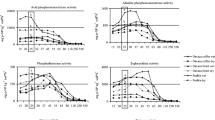Summary
The rate of reducing sugars released through invertase activity exhibited a buffer pH optimum of 5.0. Generally, the decline in invertase activity in its pH-profile near the optimal pH range was due to a reversible reaction that involved ionization or deionization of the functional groups in the active centre of the protein, but under highly acidic or alkaline conditions (pH<4 to >9) the reduced activity appears to be due to irreversible inactivation of the enzyme. The dependence of the reaction on the amount of enzyme present was linear up to 3 g of soil. By varying the substrate concentration, it was found that the reaction rate of this enzyme approached zero-order kinetics when 145mM of sucrose solution was added to soils. Application of three linear transformations of the Michaelis-Menten equation indicated that the apparent Km constants varied among the soils studied, but the results obtained by the three plots were similar. By using the Lineweaver-Burk plot, the Km values in five soils ranged from 16.3 to 42.1 (avg.=24.5) mM and Vmax values ranged from 1.98 to 7.37 mg of reducing sugars released/g of soil/24 h. The optimum temperature for invertase activity in soils was observed at 50°C and denaturation of the enzyme began at 55°C. The activation energy (Ea) and enthalpy of activation (ΔH*) values for invertase activity, expressed in kJ/mole, ranged from 6.1 to 43.1 and 3.5 to 40.5, respectively. The Q10 values for the invertase reaction in soils with a temperature range to 10 to 50°C ranged from 1.08 to 1.96. Under standerd conditions, the accumulation of reducing sugars was linear with time up to 48 h. Among the various pretreatments that affected invertase activity in soils, toluene, TCA, and PMA inhibited the enzyme by an average of 19, 54, and 11%, respectively. Steam-sterilization essentially destroyed soil invertase.
Similar content being viewed by others
References
Dalal R G 1975 Effect of toluene on the energy barriers in urease activity of soils. Soil Sci. 120, 256–260.
Dick W A and Tabatabai M A 1978 Inorganic pyrophosphatase activity of soils. Soil Biol. Biochem. 10, 59–65.
Frankenberger W T Jr and Johanson J B 1982 Effect of pH on enzyme stability in soils. Soil Biol. Biochem. 14, 433–437.
Frankenberger W T Jr and Johanson J B 1983 Method of measuring invertase activity in soils. Plant and Soil 74, 301–311.
Frankenberger W T Jr and Tabatabai M A 1980 Amidase activity in soils: I. Method of assay. Soil Sci. Soc. Am. J. 44, 282–287.
Galstyan A S 1965 A method of determining the activity of hydrolytic enzymes in soil. Pochvovedenie 2, 68–74.
Hofmann E and Hoffmann G 1961 Über die Zuverlässigkeit der Methoden zur Bestimmung der Aktivitat von Bodenenzymen nach Ed. Hofman. Plant and Soil 14, 96–99.
Hofstee B H J 1952 On the evaluation of the constants Vm and Km in enzyme reactions. Science 116, 329–331.
International Union of Biochemistry Nomenclature Committee 1979 Enzyme Nomenclature. p. 280. Academic Press, New York.
McLaren A D 1978 Kinetics and consecutive reactions of soil enzymes. pp. 97–116.In Soil Enzymes. Ed. R G Burns. Academic Press, New York.
Metzenberg R L 1963 The purification and properties of invertase ofNeurospora. Arch. Biochem. Biophys. 100, 503–511.
Myrbäck K 1960 Invertases. pp 379–396.In The Enzymes, vol 4. Ed. P D Boxer, Academic Press, New York.
Neumann N P and Lampen J O 1967 Purification and properties of yeast invertase. Biochem. 6, 468–475.
Pancholy S K and Rice E L 1973 Carbohydrases in soil as affected by successional stages of revegetation. Soil Sci. Soc. Am. Proc. 37, 227–229.
Ross D J 1975 Studies on a climosequence of soils in tussock grasslands. 5. Invertase and amylase activities of topsoils and their relationships with other properties. N.Z. J. Sci. 18, 511–518.
Segel I H 1975 Behavior and analysis of rapid equilibrium and steady-state enzyme systems.In Enzyme Kinetics, pp 926–942. John Wiley & Sons, New York.
Segel I H 1976 Biochemical Calculations, 2nd Ed. John Wiley & Sons, New York.
Skujins, J J 1967 Enzymes in soil. pp. 371–414In Soil Biochemistry, Vol. I. Eds. A D McLaren and G H Peterson. Marcel Dekker, New York.
Tabatabai M A and Bremner J M 1970 Arylsulfatase activity of soils. Soil Sci. Soc. Am. Proc. 34, 225–229.
Tracey M V 1963 The substrate constant for yeast invertase. Biochim. Biophys. Acta 77, 147–149.
Author information
Authors and Affiliations
Rights and permissions
About this article
Cite this article
Frankenberger, W.T., Johanson, J.B. Factors affecting invertase activity in soils. Plant Soil 74, 313–323 (1983). https://doi.org/10.1007/BF02181349
Received:
Revised:
Issue Date:
DOI: https://doi.org/10.1007/BF02181349




